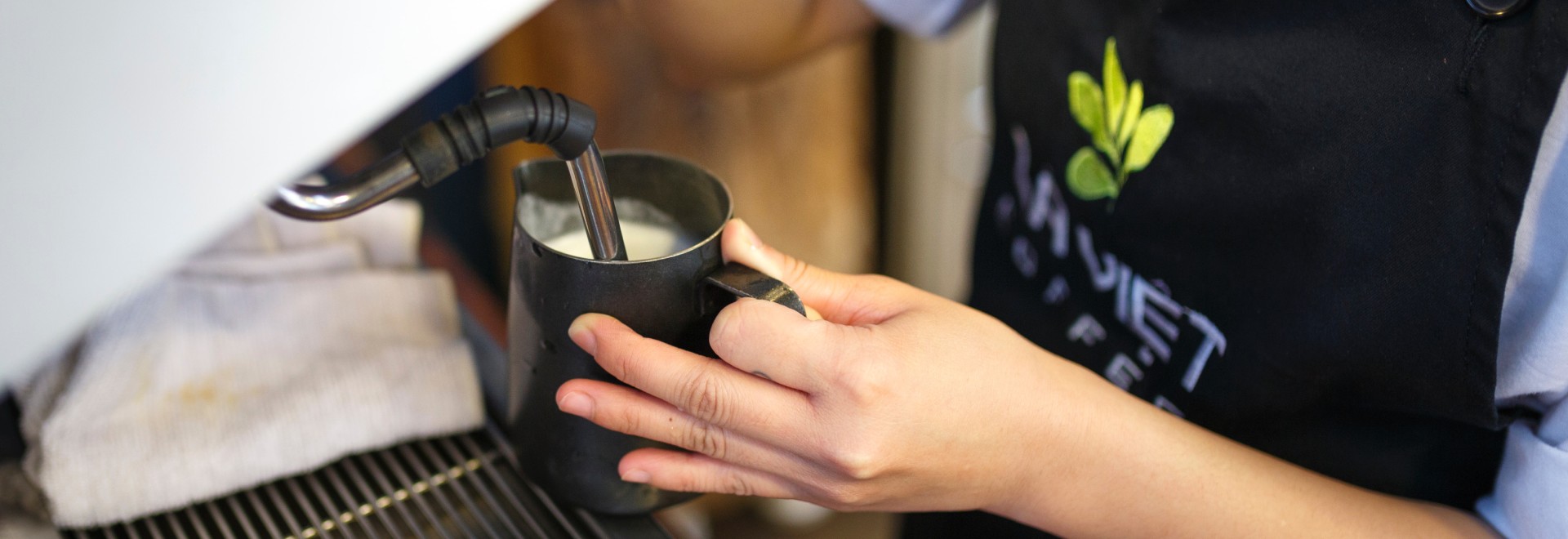Could automatic milk frothers replace the classic steam wand?
Head barista and founder of Latte Art Bar, Joao Almeida, speaks with Jenna Gottlieb about the advantages of automatic milk frothers in modern coffee shops.
Consumers associate various sounds with coffee shops, from the hum of coffee grinders, the clinking of cups, and the hiss of steam wands.
Steamed, frothed milk is an essential component of several of the world’s most popular coffee drinks, including cappuccinos, flat whites, and lattes. Baristas are trained to both create and manipulate it.
Without steamed milk, coffee drinkers wouldn’t be able to enjoy the aesthetics of latte art, the sweetness of frothed milk, or the way it balances out the bitter notes of traditional espresso.
Because of its significance in coffee culture, high-quality frothed milk is a standard expectation at specialty cafés. The way in which it is executed can be an important deciding factor for customers searching for their favourite coffee stop.
Most traditional espresso machines are equipped with one or more steam wands. These are pipes that direct hot steam – typically between 60-70°C – and air from the machine’s boiler into a jug of milk manipulated by the barista.
The combination of steam and air creates thousands of air bubbles held stable by milk proteins, fat, and other molecules. If done correctly, the result is the “microfoam” that sits atop the beverage.
However, more than ever before, cafés are beginning to weigh up the value of automatic milk frothers. They save time, use milk efficiently, and may even be more energy-efficient than traditional steam wands.
According to a 2019 report from UCC Coffee, automation is already reshaping the coffee industry. Manufacturers are increasingly developing superautomatic coffee machines that cafés can use to their advantage.
Last year, Allegra Strategies reported that more than one in two UK coffee shop consumers have used a self-service interface to order coffee. Furthermore, one in three of the same sample group indicated that they would be open to a fully-automated coffee shop experience.
With this level of customer confidence, automation seems like the natural next step in the café business.
What are automatic milk frothers?
Joao Almeida is an experienced barista and the founder of Latte Art Bar, a startup that aims to get better prices for dairy farmers who focus on animal welfare and increasing quality.
“The most common way for baristas to steam milk is from a steam wand,” he explains. “Once you work milk to a certain point, it will hold bubbles of air.”
He adds that the quality and type of milk used are crucial, especially when creating froth that needs to last more than a couple of minutes.
“Fattier milk makes it creamier. The better the milk you use, the better the results.”
Some plant milks can be especially difficult to froth. This is something a growing number of baristas are working toward perfecting, with manufacturers increasingly developing plant milks that are more compatible with the process.
According to a recent report from Mintel, one in three consumers in Britain drink plant-based milks, with usage up from 25% in 2020 to 32% in 2021.
Unlike steam wands, automatic milk frothers are seen as the next step in coffee technology, as they allow baristas and at-home consumers to create frothed milk on demand, literally at the touch of a button.
“Automatic frothers are fundamentally a way to replicate what the human barista can do,” Joao explains.
The process of steaming milk is time-consuming and must be accounted for in a barista’s daily workflow. By cutting this step out, baristas can free up time for customer engagement or more training, or they can simply reduce their daily workload.
A growing number of coffee machines incorporate automatic frothers. Carimali recently launched its Optima Ultra machine, which features the company’s CARImilk technology. It guarantees perfect milk foam at the best consistency and thickness for both hot and cold foamed milk drinks.
There are also machines like the Heylo Milk Module that, once launched, will offer the ability to froth milk without the use of steam. Instead, the machine’s induction technology is able to texture dairy and plant milks alike. Because it doesn’t rely on an always-on boiler, it can save on energy costs.
Will automatic milk frothers become the norm?
Some argue that technology is improving the experience for both baristas and customers, but coffee professionals might feel sceptical about automation.
That’s why these products are positioned as brewing aids, not replacements for well-trained professionals. A good example is latte art, which requires significant skill to produce. Even though the automatic frother prepares the milk, it’s up to the barista to execute the final touches that truly impress customers.
While some coffee professionals may feel that there’s no replacement for a barista, perhaps it’s time to recognise that equipping cafés and their staff with the best tools available has immense benefits.
Automatic milk frothers can be helpful in high-volume cafes where baristas are working at full capacity. Most busy cafés also experience regular “rushes”, which often lead to more mistakes, worse coffee, and unwanted stress.
Furthermore, by freeing up time for customer engagement in cafés, these devices have the potential to improve customer retention and coffee education. Essentially, automatic machines don’t exist to replace baristas. Instead, technology can help them display their skills and knowledge even more than before.
Joao adds that many years ago, before quality steamed milk was widely available, customers were wowed by any sort of milk foam. However, he believes that today’s consumers are only willing to pay premium prices for quality.
In a broader sense, research backs this idea up. A 2021 study found that in the coffee sector, consumer behaviour is significantly influenced by the proper preparation of coffee.
“Coffee is considered a high-quality food,” the study asserts. “In the minds of consumers, consumption of coffee is more and more often equated with pleasure and positive experiences and is related to lifestyle and social status.”
However, Joao adds that customers may still be reluctant to put the same trust in machines that they do in baristas.
Ultimately, the very best automatic milk frothers are touted for their precision and consistency, with little room for error. Furthermore, in a café setting, they still require the supervision of a barista.
Baristas are required to adapt to changes on the go and the introduction of automation in the workplace is an adjustment with positive benefits.
And, in spite of all apprehensions, one thing is clear: automation in the coffee sector isn’t going anywhere. In fact, according to a 2021 UCC Coffee report, the global automation market is expected to grow by as much as 30% by 2025.
For now, baristas can experience the benefits of this technology while adding their human touch.








